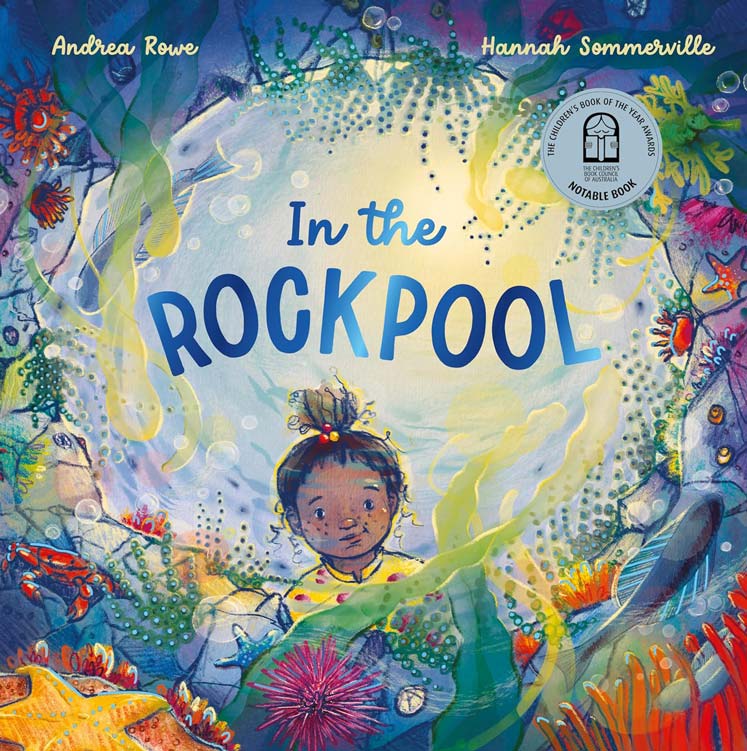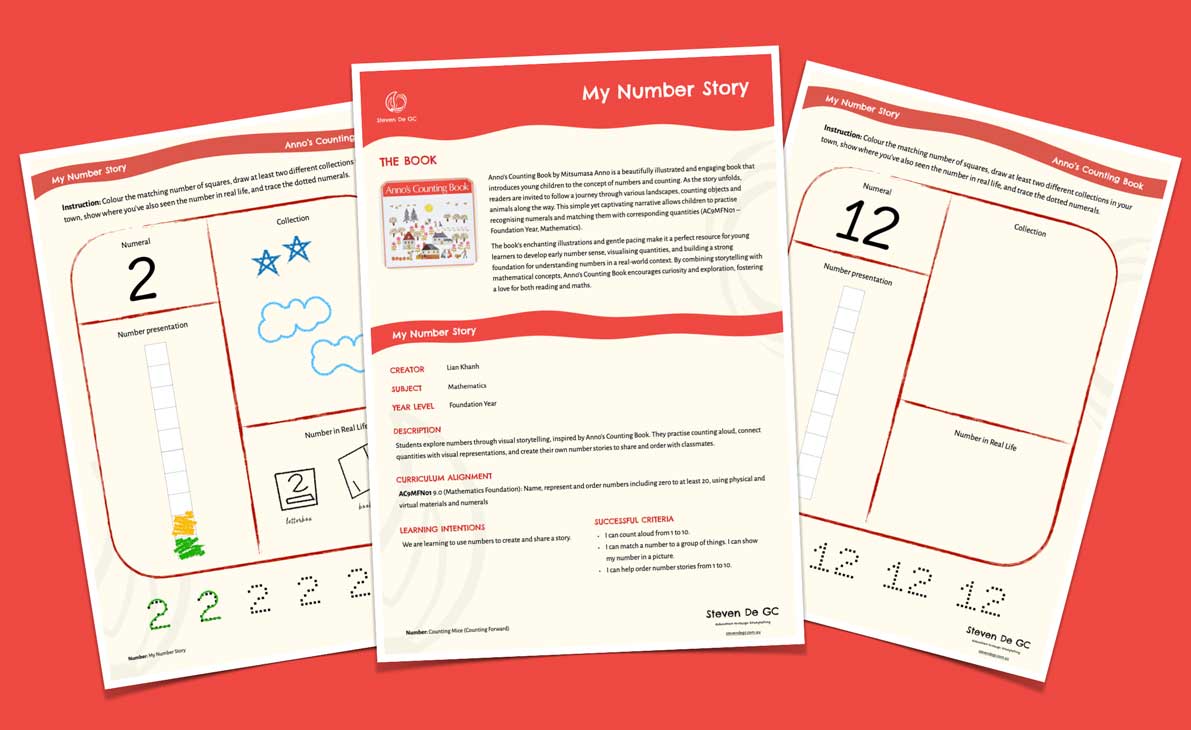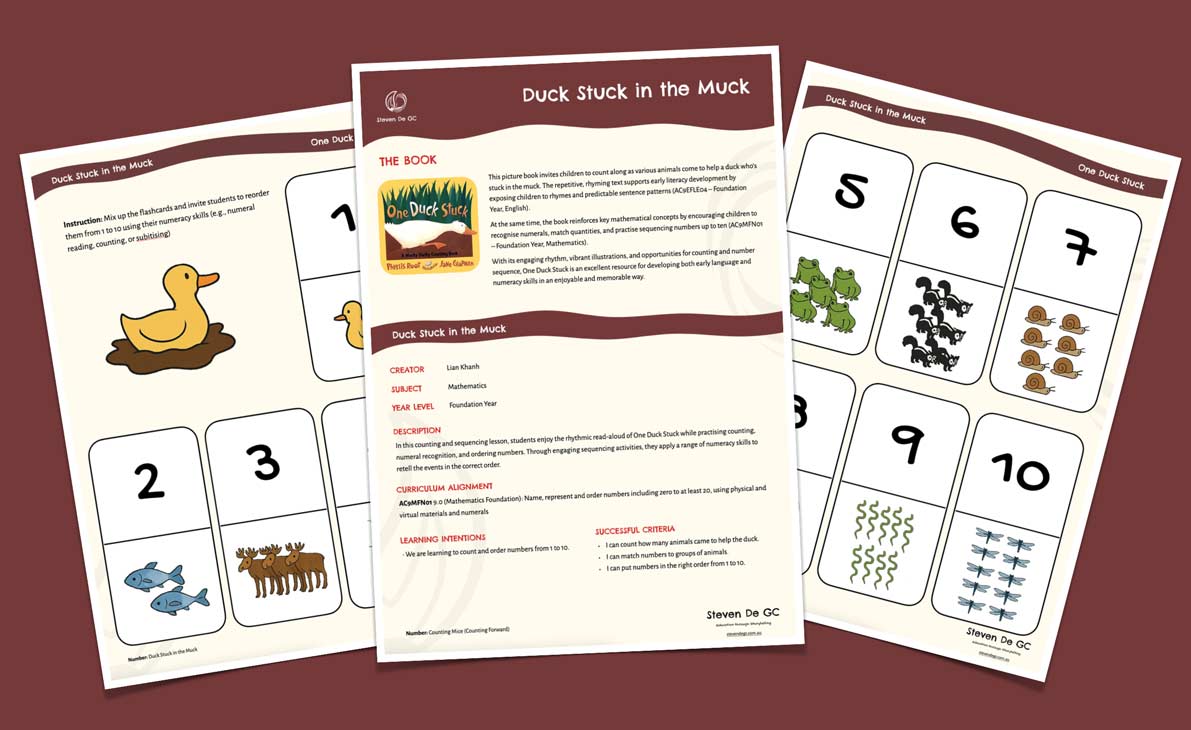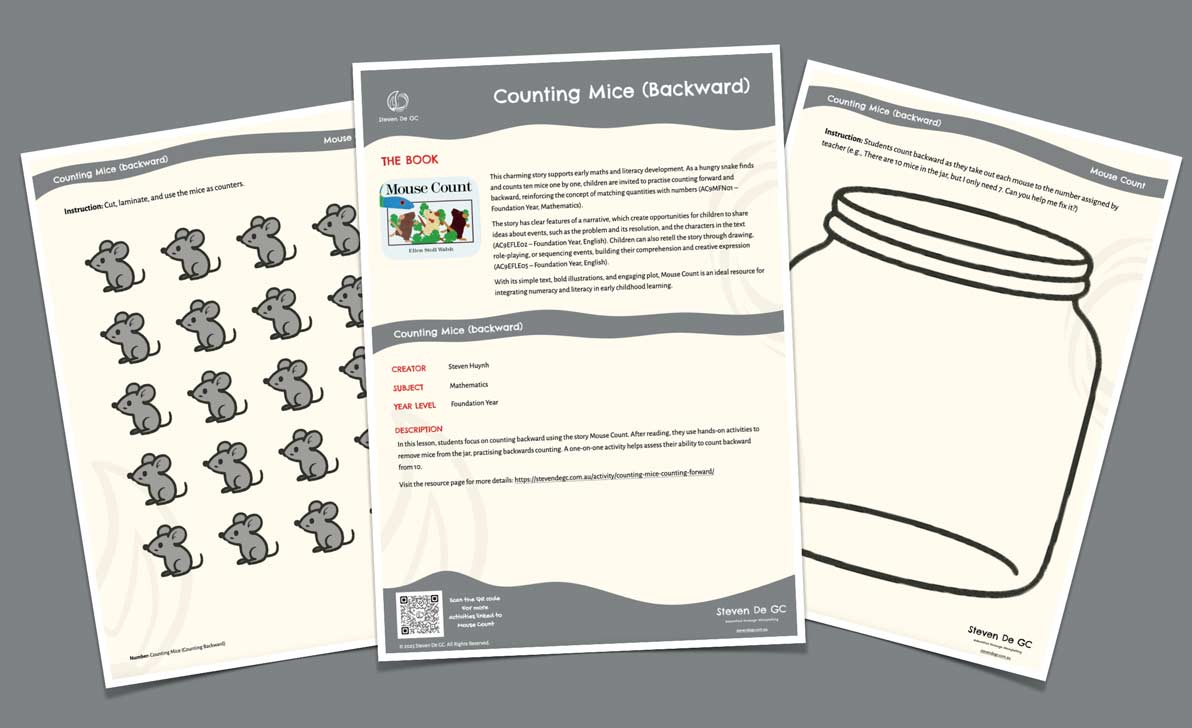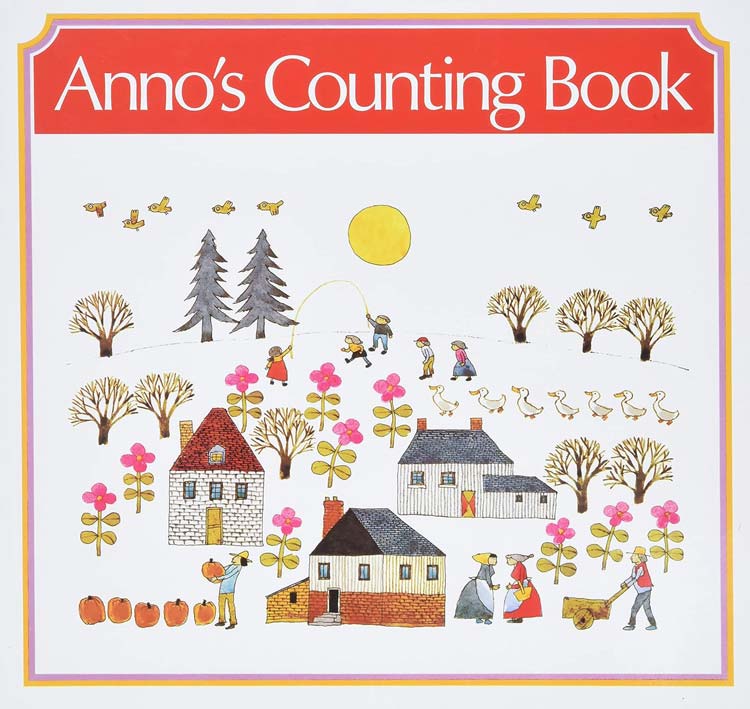AC9MFN01
Mathematics | Foundation
Name, represent and order numbers including zero to at least 20, using physical and virtual materials and numerals
Elaborations
• responding to a request to collect a quantity of objects or reading a numeral and selecting the associated quantity of items from a collection to match the number required; for example, collecting 9 paint brushes after hearing the word ‘nine’
• recognising the order in the sequence of numbers to (20) and identifying the number that is “one less” than a given number and the number that is “one more”; for example, playing instructive card games that involve reading and ordering number cards; using counting songs, story books and rhymes to establish the forwards and backwards counting sequence of numbers in the context of active counting activities
• understanding and using terms such as “first”, “second”, “third”, … “fifth”… to indicate ordinal position in a sequence; for example, creating a number track using cards with the numerals zero to (20) and describing positions using terms such as first, last, before, after, between
• recognising, writing and reading numerals written on familiar objects; for example, in images, text or illustrations in story books; writing a numeral on a container as a label to show how many objects it contains
• connecting quantities to number names and numerals when reading and reciting stories and playing counting games or determining and reasoning about the size of sets of objects within First Nation Australians’ instructive games; for example, Segur etug from Mer Island in the Torres Strait region
Expand | Collapse Search filter
-
In The Rockpool
Written by Andrea Rowe
Illustrated by Hannah Sommerville
Published by Little Hare Books
Theme/topic: Counting, Habitats, and Ocean
Suggested learning area: AC9MFN01 (Mathematics – Foundation) AC9S1U01 (Science – Year 1)The book invites young readers on a sensory exploration of the creatures and treasures found in coastal rockpools. The story encourages children to observe and describe the natural features of seaside habitats, including the plants and animals that live there, supporting understanding of animal needs and environments (AC9S1U01 – Year 1, Science).
As children engage with the rhythmic text and detailed illustrations, they also practise early number skills, such as counting shells, crabs, and other seaside items, reinforcing concepts of matching quantities with numerals and naming numbers in sequence (AC9MFN01 – Foundation Year, Mathematics).
This book is a rich cross-curricular resource, perfect for supporting science and maths learning through storytelling, observation, and wonder.
My Number Story
📔 Anno’s Counting Book by Mitsumasa Anno• We are learning to use numbers to create and share a story.
Duck Stuck in the Muck
📔 One Duck Stuck by Phyllis Root• We are learning to count and order numbers from 1 to 10.
Counting Mice (Counting backward)
📔 Mouse Count by Ellen Stoll Walsh• We are learning to count backward from 10.
Counting Mice (Counting forward)
📔 Mouse Count by Ellen Stoll Walsh• We are learning to count objects and match them to numbers.
Anno’s Counting Book
Written & illustrated by Mitsumasa Anno
Published by HarperCollins AU
Theme/topic: Counting
Suggested learning area: AC9MFN01 (Mathematics – Foundation)Anno’s Counting Book by Mitsumasa Anno is a beautifully illustrated and engaging book that introduces young children to the concept of numbers and counting. As the story unfolds, readers are invited to follow a journey through various landscapes, counting objects and animals along the way. This simple yet captivating narrative allows children to practise recognising numerals and matching them with corresponding quantities (AC9MFN01 – Foundation Year, Mathematics).
The book’s enchanting illustrations and gentle pacing make it a perfect resource for young learners to develop early number sense, visualising quantities, and building a strong foundation for understanding numbers in a real-world context. By combining storytelling with mathematical concepts, Anno’s Counting Book encourages curiosity and exploration, fostering a love for both reading and maths.
One Duck Stuck
Written by Phyllis Root
Illustrated by Jane Chapman
Published by CWP
Theme/topic: Counting, Repetition, and Rhyme
Suggested learning area: AC9EFLE04 (English Language and Literacy – Foundation) AC9MFN01 (Mathematics – Foundation)This picture book invites children to count along as various animals come to help a duck who’s stuck in the muck. The repetitive, rhyming text supports early literacy development by exposing children to rhymes and predictable sentence patterns (AC9EFLE04 – Foundation Year, English).
At the same time, the book reinforces key mathematical concepts by encouraging children to recognise numerals, match quantities, and practise sequencing numbers up to ten (AC9MFN01 – Foundation Year, Mathematics). With its engaging rhythm, vibrant illustrations, and opportunities for counting and number sequence, One Duck Stuck is an excellent resource for developing both early language and numeracy skills in an enjoyable and memorable way.
Mouse Count
Written & illustrated by Ellen Stoll Walsh
Published by HMH Books
Theme/topic: Counting and Narrative
Suggested learning area: AC9EFLE02 (English Language and Literacy – Foundation) AC9EFLE05 (English Language and Literacy – Foundation) AC9MFN01 (Mathematics – Foundation)This charming story supports early maths and literacy development. As a hungry snake finds and counts ten mice one by one, children are invited to practise counting forward and backward, reinforcing the concept of matching quantities with numbers (AC9MFN01 – Foundation Year, Mathematics).
The story has clear features of a narrative, which create opportunities for children to share ideas about events, such as the problem and its resolution, and the characters in the text (AC9EFLE02 – Foundation Year, English). Children can also retell the story through drawing, role-playing, or sequencing events, building their comprehension and creative expression (AC9EFLE05 – Foundation Year, English).
With its simple text, bold illustrations, and engaging plot, Mouse Count is an ideal resource for integrating numeracy and literacy in early childhood learning.
Bears On Wheels (Counting)
📔 Bears on Wheels by Jan Berenstain and Stan Berenstain• Students will practise counting numbers up to 10.
Let’s Count Feet
📔 One Is a Snail, Ten Is a Crab by April Pulley Sayre and Jeffrey Sayre• Students are practising basic counting skills up to 10.
Dino Counting – One less concept
📔 Ten Little Dinosaurs by Mike Brownlow• Students are learning to count backwards through the one-less number concept.
Ten Little Dinosaurs
Written by Mike Brownlow
Illustrated by Simon Rickerty
Published by Orchard Books
Theme/topic: Mathematics
Suggested learning area: AC9MFN01 (Mathematics – Foundation) ACELA1439 (English Language and Literacy – Foundation) ACMNA001 (Mathematics – Foundation) ACMNA002 (Mathematics – Foundation)This delightful rhyming adventure captivates young readers with its playful text and vibrant illustrations. The story counts down from 10 to 1 as a group of mischievous little dinosaurs encounters various adventures and challenges, blending humour with basic counting skills (ACMNA001, AC9MFN01 – Foundation Year, Mathematics). It connects number names, numerals, and the number of dinosaurs (ACMNA002 – Foundation Year, Mathematics), making it a valuable tool for early numeracy. The rhymes and repetitive patterns not only entertain but also foster language development and phonemic awareness (ACELA1439 – Foundation Year, English). With its engaging narrative and educational focus, Ten Little Dinosaurs is a perfect read-aloud choice for young children, combining fun and learning in one enjoyable package.
Bears on Wheels
Written & illustrated by Jan Berenstain and Stan Berenstain
Published by Random House Books for Young Readers
Theme/topic: Mathematics
Suggested learning area: AC9MFN01 (Mathematics – Foundation) ACMNA001 (Mathematics – Foundation) ACMNA002 (Mathematics – Foundation) ACMNA003 (Mathematics – Foundation)This lively and engaging story introduces young readers to basic counting from 1 to 10 (ACMNA001, AC9MFN01 – Foundation Year, Mathematics). The simple yet entertaining narrative follows bears as they ride on wheels in various configurations, showcasing relationships between numbers and objects (ACMNA002 – Foundation Year, Mathematics). Through its use of repetitive patterns and clear visual representations, the book helps children practise subitising small collections (ACMNA003 – Foundation Year, Mathematics). With its playful illustrations and rhythmic text, Bears on Wheels is an excellent resource for building early numeracy skills in an enjoyable and interactive way.
One Is a Snail, Ten Is a Crab
Written by April Pulley Sayre and Jeffrey Sayre
Illustrated by Randy Cecil
Published by Walker Books
Theme/topic: Mathematics
Suggested learning area: AC9MFN01 (Mathematics – Foundation) ACMNA001 (Mathematics – Foundation) ACMNA002 (Mathematics – Foundation) ACMNA031 (Mathematics – Year 2)This delightful and imaginative book introduces young readers to counting (ACMNA001, AC9MFN01 – Foundation Year, Mathematics) and basic multiplication concepts. By using the number of feet on various animals, the story encourages children to explore basic counting with feet (ACMNA002 – Foundation Year, Mathematics) and repeated addition, grouping, and arrays to represent numbers. This creative approach not only reinforces counting skills but also provides a playful foundation for understanding multiplication (ACMNA031 – Year 2, Mathematics). Additionally, the book supports early number recognition and sequencing as children practice counting and comparing quantities. With its vibrant illustrations and humorous scenarios, this book engages young learners while fostering critical thinking and problem-solving skills in an enjoyable way.



